
16 minute read
HYDROGEN
Beyond BEV
As OEMs and racing bodies look for an alternative to pure battery electric, hydrogen propulsion concepts are developing fast. Racecar looks at the current state of play

By Lawrence Butcher
Battery-powered electric vehicles (BEVs) may be the enfant gâté as the world transitions to low-carbon propulsion, but talk to most experts with a realistic view on decarbonisation and they will assert that BEVs are far from a catch-all solution. The raft of issues surrounding everything from sourcing materials such as lithium and cobalt, through the sticky subject of what to do with batteries at end of life – not to mention the sheer size of packs needed to extract reasonable range from vehicles – mean that adding batteries to everything from scooters to boats and ’planes is simply not a sustainable option.
The reality is that (notwithstanding politicians being unable to understand more than one solution) BEVs will be part of a wider range of low-carbon solutions, incorporating both synthetic fuels and, the subject of this article, hydrogen.
The development of what is referred to as the ‘hydrogen economy’ is already well underway, though admittedly at diff erent rates across the world. In some places such as Japan, the implementation of widespread hydrogen infrastructure is progressing at pace. For Europe, progress is slower, but gathering momentum with most countries, and the EU, having now developed hydrogen roadmaps.
The benefi t of hydrogen from an emissions perspective is that when combusted (in an ICE) or reacted (in a fuel cell), the only signifi cant by product is water (though NOX can be an issue when used in combustion engines).


GCK Motorsport’s e-Blast racer has an electric battery and hydrogen fuel cell on board and was showcased at the 2021 Dakar Rally to demonstrate the application of fuel cell technology in racing. The French company’s updated version, e-Blast H2, was presented in prototype form at last year’s event, and will race competitively in 2024
Diagrammatic representation of a proton exchange hydrogen fuel cell


The principle of operation is similar to that of a battery, featuring an anode and a cathode, but utilising the inherent chemical energy of the hydrogen

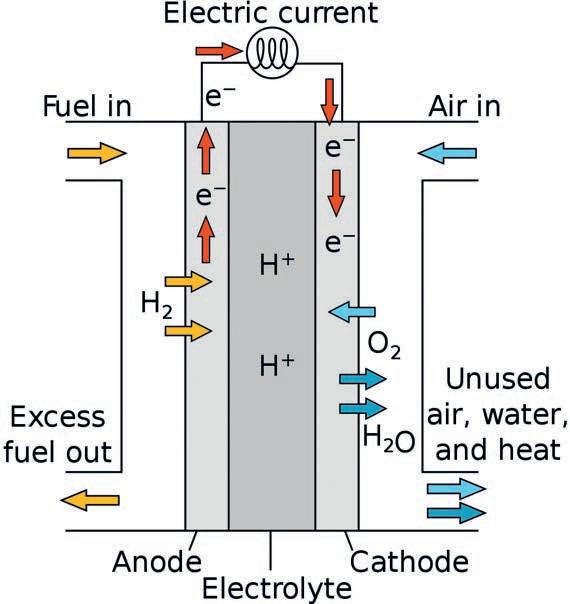







» The benefit of hydrogen from an emissions perspective is that when combusted (in an ICE) or reacted (in a fuel cell), the only significant by product is water






The first hydrogen-powered entry on the Dakar Rally was the H2 built by Gaussin of France. It featured a 380kW fuel cell, 82kWh battery and twin 300kW motors. It successfully completed the 2022 event
However, despite hydrogen being the most prevalent element in the universe, it tends to be fi xed in compounds and needs to be separated out. The two most common methods used for this are steam-methane reforming (SMR) and electrolysis, both of which require considerable amounts of energy. Depending on the source of that energy determines how ‘clean’ is hydrogen from an emissions sense.
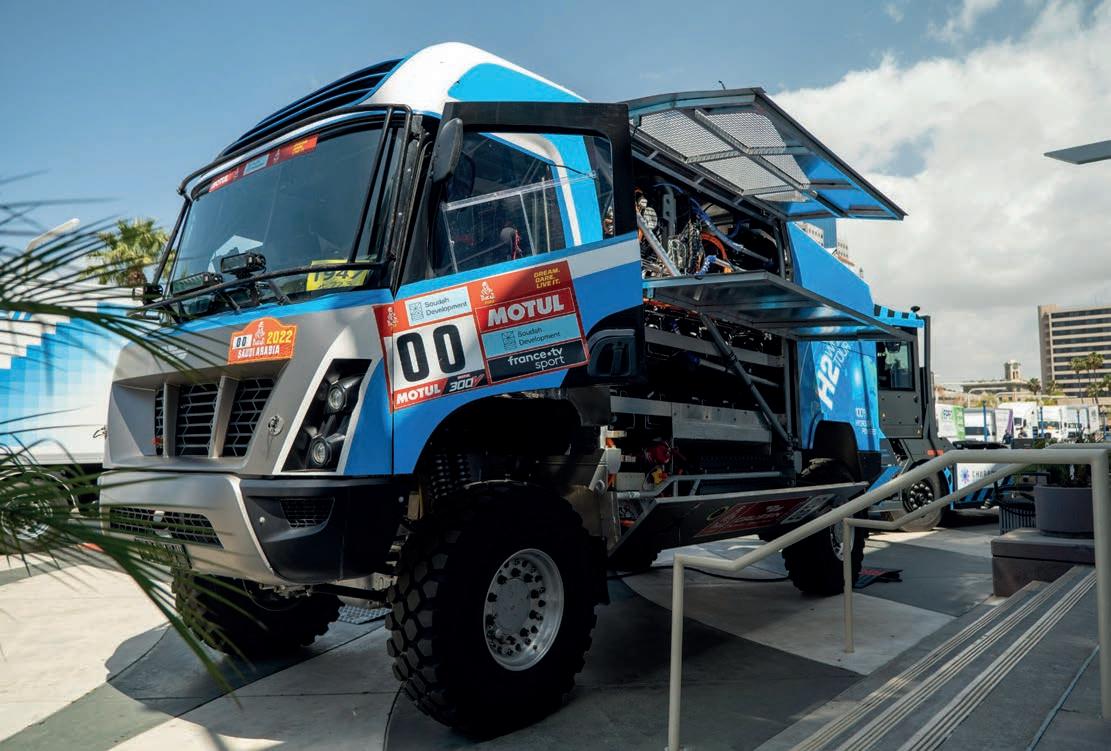

Grey, Blue and Green

Where non-renewable energy is used for SMR (think coal or gas power stations), one obtains Grey hydrogen. If the SMR process uses carbon-capture techniques, the resulting gas is called Blue hydrogen. Lastly, if electrolysis powered by carbon-neutral, renewable energy is used, Green hydrogen is the result.
Currently, most of the world’s hydrogen is Grey, but considerable eff orts are underway to transition to Blue and Green production methods. Of course, using energy to refi ne hydrogen is less effi cient than simply putting it directly into a battery (SMR is around 65 per cent effi cient, the latest electrolysis plants around 80 per cent), but the benefi ts of having a relatively easily transported energy storage medium are considerable. Not least because many of the best locations for renewable energy generation are not in parts of the globe where that energy is most needed. The coastline of South America, for example, for wind generation, or the deserts of Africa for solar. Convert that energy into hydrogen, or a carrier medium such as ammonia (which is easier to liquefy at just -33degC and contains 1.7 times more hydrogen per cubic metre than liquefi ed hydrogen) and it can be shipped around the world in bulk carriers.
Pound for pound, hydrogen also has higher energy density than even the latest battery technology, 35,000W/kg compared to the lithium-ion technologies at around 4-500W/kg. So, if you can compress it enough (or store it as liquid), greater range can be extracted from a hydrogen-powered vehicle at a lower weight than a BEV. Hydrogenfuelled vehicles can also be refuelled at a much faster rate than a BEV can be charged.

Hydrogen in motorsport
Thanks to these advantages, hydrogen is fi rmly in the sights of a number of OEM vehicle manufacturers, with even greater interest being shown for freight vehicles and aviation. Inevitably too, various hydrogen-fuelled motorsport endeavours are currently underway as well.
The forms of hydrogen propulsion relevant to motorsport can be broken down into two classes: hydrogen fuel cell-powered EV (FCEVs) and hydrogen-fuelled ICE. Both approaches are being deployed in racing currently but, for the purposes of this article, we will focus on the former. One can already buy FCEV road cars in the form of the Toyota Mirai and Honda Clarity, and FCEVs have competed in a number of racing disciplines.
With trucks, the area of transport where fuel cells are being adopted more widely, it was fi tting that the fi rst hydrogen entry on the Dakar Rally be a truck produced by French specialist vehicle manufacturer, Gaussin. Its H2 Racing Truck fi nished the 2022 Rally and features a 380kW fuel cell coupled to an 82kWh battery and a pair of 300kW motors, all housed within a lightweight
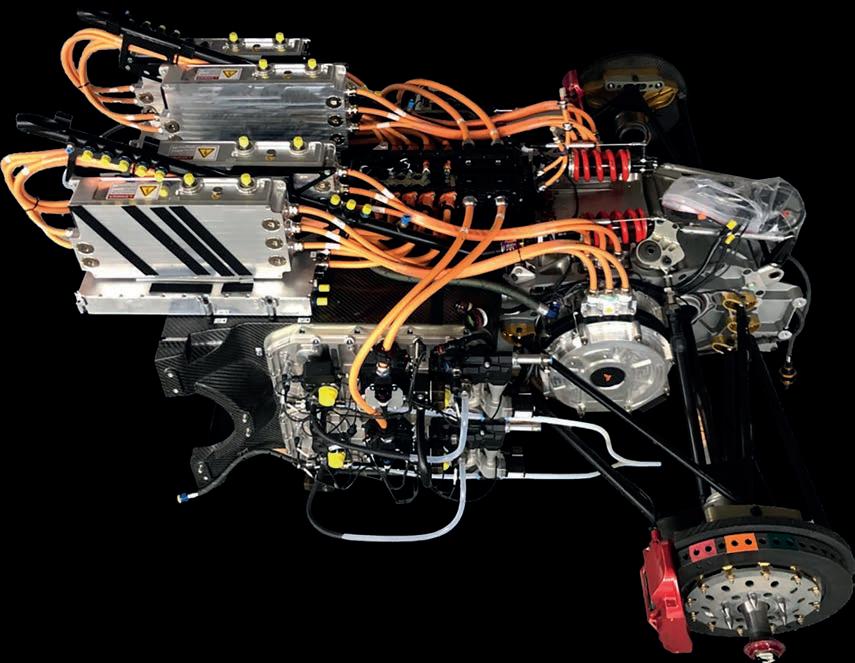
Franco Swiss outfit, GreenGT, has been working on a hydrogen fuel cell-powered racecar for years. In this early iteration, the fuel cell was linked to the traction motors


‘skateboard’ chassis developed specifi cally for hydrogen-based electrifi cation.
Also set to compete on the Dakar in 2024 is a fuel cell-powered car under development by GreenKorp Connection (GCK), headed by French Rally driver and skier, Guerlain Chicherit. The e-Blast H2 is being developed with input from advanced powertrain design specialist, FEV, and will feature a bespoke fuel cell and storage tank system.
Scuderia Cameron Glickenhaus is also working on a fuel cell power entry for the Baja 1000.
Currently competing in a more traditional track setting is Franco Swiss fi rm, GreenGT, running a FCEV Prototype with the Michelin Le Mans Cup as a test bed for the ACO and FIA’s future H2 hydrogen class at Le Mans, which we will return to in greater detail shortly.

Fuel cell technology
First, though, it is worth looking at what a fuel cell is, and how it works. Invented in 1839 by Welsh scientist, William Robert Grove, the principle of operation for a fuel cell is much like that of a battery, featuring an anode and a cathode and utilising the chemical energy of, in this case, hydrogen.
In a hydrogen fuel cell, the anode and cathode are surrounded by electrolyte and a catalyst at the anode separates hydrogen molecules into protons and electrons. The protons move through the electrolyte to the cathode, while the electrons pass through an external circuit, creating a fl ow of electricity. Once the protons have reached the cathode, they combine with oxygen, creating water and heat as by-products of the process.
There are a variety of diff erent fuel cell types available, but those of greatest interest for automotive, and motorsport, rely on Proton Exchange Membrane (PEM) technology. PEMFCs have a number of desirable attributes. For example, they operate at relatively low temperature (under 100degC), have high effi ciency and can be started up and shut down rapidly.
A PEMFC uses a polymer electrolyte for conducting the protons, such as perfl uorosulfonic acid, in the form of a membrane, onto which is painted the catalysing anode and cathode material (normally platinum particles in a carbon support). This assembly is sandwiched between gas diff usion layers (GDL), which facilitate the transport of reactants to the catalyst layers and the removal of water.
The resulting layered component is known as a membrane electrode assembly (MEA). Multiple MEAs are assembled in series using bipolar plates, increasing the output voltage to a useful level, and creating a fuel cell stack ranging in power from one to over 100kW. These stacks then tend to be bundled together to increase system power.
A variety of ancillary systems are needed in addition to the cell stack, such as an air compressor, which pushes air through the stack supplying oxygen for the cathode reaction. Thermal management and cooling systems, as well as a DCDC converter are also used and high pressure storage tanks for the hydrogen.
Transient performance
One thing fuel cells tend not to be so good at is transient performance. Therefore most FCEVs rely on a high power density buff er battery, facilitating rapid
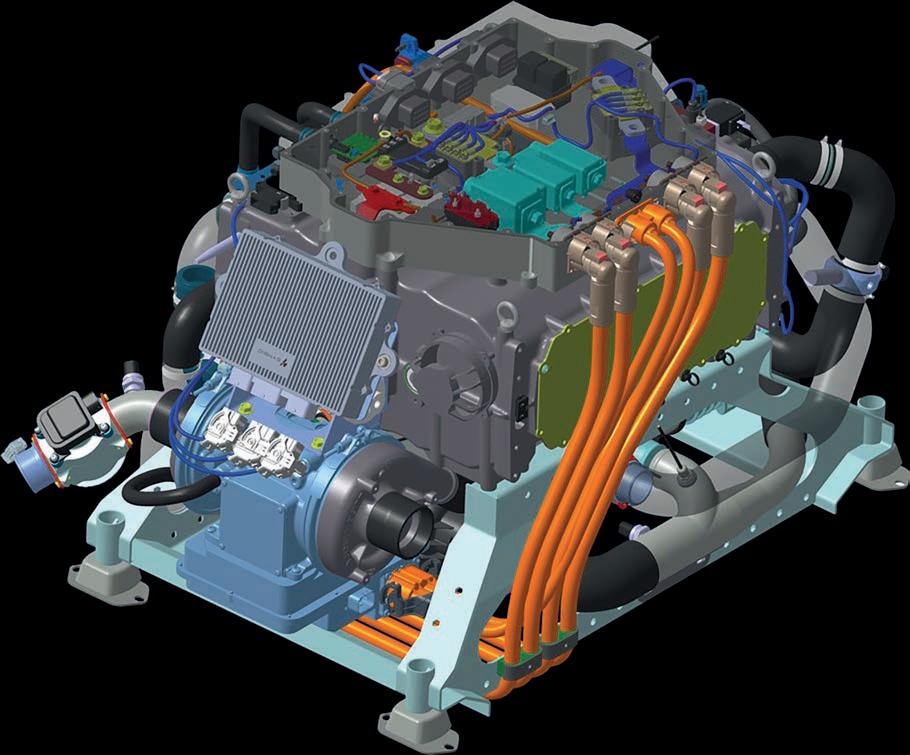
GreenGT has been developing its fuel cell package, increasing power and reducing size and weight, down from 400kg to 133kg in this iteration. Power output is 250kW



changes in power deployment as well as energy recuperation under braking.
Competition ready, the car fi elded by Green GT in the Michelin Le Mans Cup is a good example of the current state of the art for high-power fuel cell integration. The ACO has set its sights on establishing a class for hydrogen fuel cell cars at Le Mans in 2025, and part of its plan to achieve this is via a partnership with GreenGT, which has been working on the development of a hydrogen fuel cell racer for many years. The company’s test mules have evolved considerably from the rather wild-looking H2, which was intended for a Garage 56 entry in 2013, and it now has a fully operational racecar based on an ADESS LMP3 chassis.
Over the last decade, the company has steadily increased the potency of its fuel cell package, both upping the power and reducing its size and weight. The fi rst iterations used a road car-derived fuel cell with 18 stacks, while the current system uses a more active surface chemistry on the fuel cell membrane and only features four stacks, with an output of 250kW. While versions of the old cell were higher power, developing up to 320kW, weight has been reduced from 400kg to the current cell’s 133kg.
The fuel cell is fed air via a high effi ciency compressor and a buff er battery between the cell, while the four electric traction motors allow for regenerative braking and storage of energy from the cell when it is not immediately required. The car is fuelled with gaseous hydrogen, rather than liquid.
The company’s early cars had the fuel cell linked directly to the traction motors. But by adding a battery into the system, it was possible to double the energy available for the motors at peak demand. The 2.4kWh battery can deliver 300kW over 20 seconds.
The company worked with a Formula 1 battery supplier on the development of the buff er and, with power rather than energy density the priority, was able to achieve an astounding 150 C-rate.

Mans in 2025

Packaging and weight
‘The main target we have at the moment is to reduce the weight of the system, which is critical. We are not touching the fuel cell itself, because over the last four years it has proved very stable,’ explained Jean-François Weber, MD and head of R&D at GreenGT, speaking at Le Mans this year.
‘We have focussed our work on the accessories – things like the compressor, the cooling – and the aerodynamics of the car.’
It is notable that the fuel cell element of the GreenGT is considered adequate in terms of performance, with the main challenges now being keeping other components cool and packaging everything within the constraints of a Sports Prototype chassis.
Let’s be clear though, the cooling demand of the battery and motors at full power is considerable.

‘When we combine the fuel cells and battery, we are near 500-520kW,’ says Weber. That’s why the car features a somewhat unusual, roof-mounted scoop for supplying cooling air to the motors and battery. Due to the sidepods being occupied by a pair of hydrogen tanks, there is only space in the sides for the fuel cell cooling circuit, hence the need for the additional roof scoop. ‘We need to re-think the defi nition of the cars and where we put the various components,’ suggests Weber.
The fuel cell is due for further development, both to cut its weight and increase performance. ‘We started four years ago on [the development] of composite bipolar plates, and on the MEA we have some developments to improve the active surface, but we cannot give more details on that yet,’ says Weber. ‘We hope to reduce the volume by 30 per cent and improve the weight by effi ciency. We are at the point where we can compete with IC engines and the curve for development is very steep.’
Currently, the team is limited in how far it can go with overall vehicle architecture changes as the existing fuel tank design is the only one homologated for racing.‘ With the regulations, we cannot do everything we hoped we could,’ muses Weber.
Looking to the future, though, there are several promising options that should make packaging hydrogen tanks less burdensome.
GreenGT had this FCEV Sports Prototype running at Le Mans last year as a test mule for the ACO and FIA’s proposed H2 hydrogen class, which is scheduled for Le Mans competition in 2025

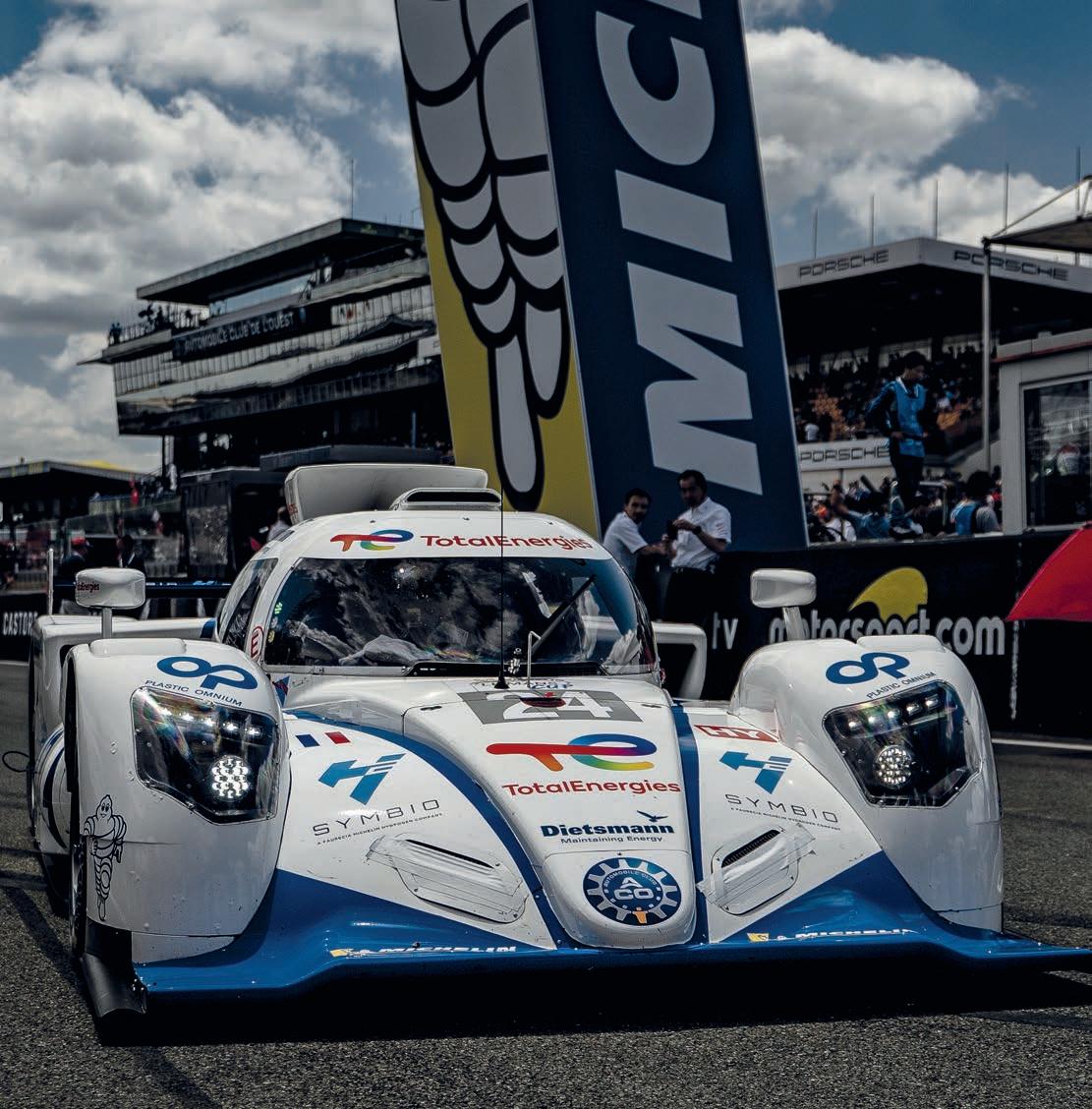
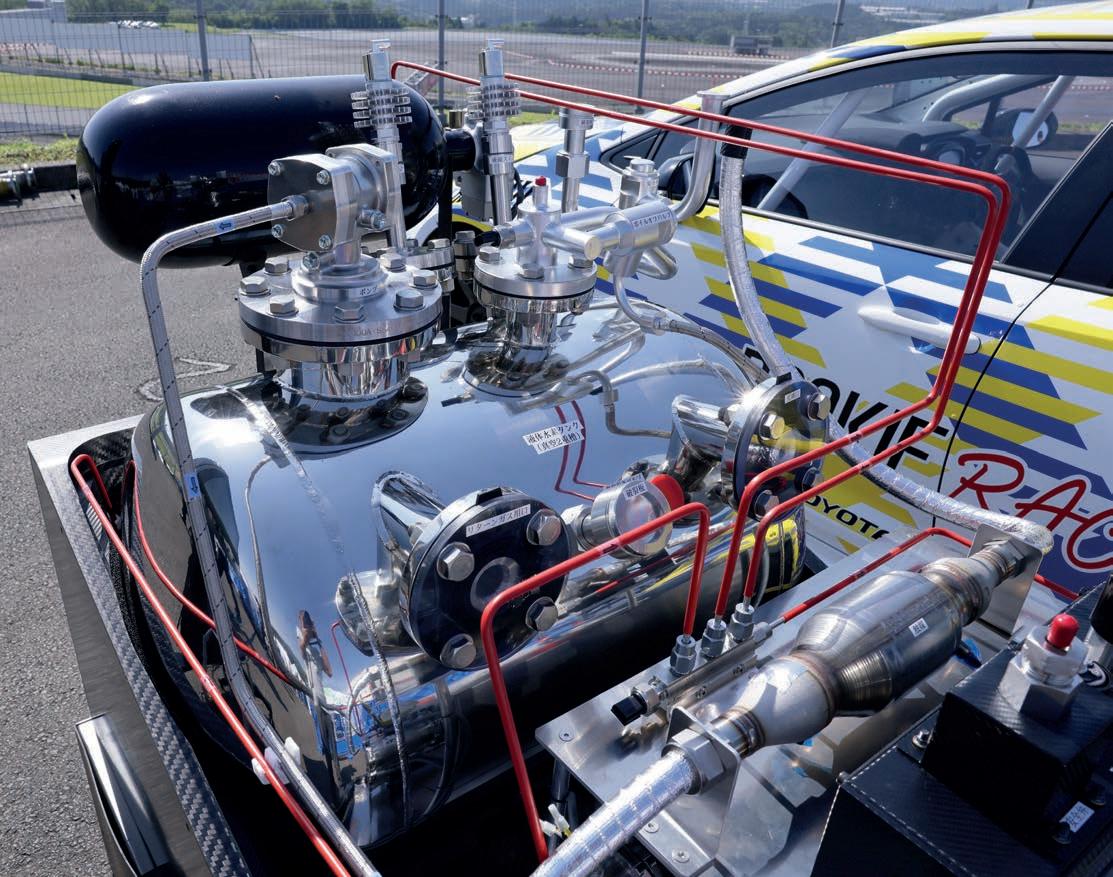
Toyota has been pushing ahead with its hydrogen project, competing with a hydrogen-fuelled ICE Corolla in the Super Taikyu series, and developing this mobile liquid refuelling station


For example, a UK-based company called Viritech, with former F1 engineer, Mat Faulks, as its CTO, has patented a design for structural tanks. Produced from a graphene composite, the tanks are intended to act as stressed members, allowing for better integration into a vehicle and a considerable weight reduction.
A move to cryogenic-cooled liquid fuel would also greatly reduce the tank size needed to achieve representative stint lengths at a track like Le Mans. ‘The volume would go down three to fi ve times,’ observes Weber.
Thanks to liquid hydrogen being stored at much lower pressure, the need for cylindrical tanks is also removed, adding further packaging fl exibility. Though the industry standard for automotive currently centres around gaseous hydrogen, moves are afoot, particularly in the freight sector, to develop liquid fuel systems and infrastructure.
It is notable too that in Japan, Toyota is progressing with work on a mobile liquid refuelling system for its hydrogen-fuelled ICE Corolla, currently racing in the Super Taikyu series.
The Japanese company has also been pushing the capabilities of gaseous refuelling. For example, by increasing the size of the car’s fuel port and nozzle, coupled with a rise in pressure from 40MPa to 60MPa, it can now fi ll the car’s twin tanks in around one and a half minutes, compared to fi ve minutes when the project commenced in 2021.

Development rate
The eff orts of GreenGT and others across diff erent motorsport genres will, it is hoped, accelerate the development rate of hydrogen fuel cell systems. However, suitable regulation and the infrastructure to make it work on a larger scale lags behind the currently available technology.
Regulation constraints have already slowed the development of innovative storage solutions for GreenGT, while trackside infrastructure needs considerable investment if hydrogen-fuelled cars are to compete in signifi cant numbers. Taking Le Mans as an example, the bunkering required to provide petrol for a grid of 60+ cars is huge, and even just the installation of hydrogen tanks and supply lines for fi ve cars would be a major undertaking, let alone a full grid. But, if 2025 remains the target for an H2 class, such work will need to begin soon.
Hydrogen almost certainly has a future in motorsport, but regulators and race series organisers need to remain fl exible for the technology to prove its potential. l




















